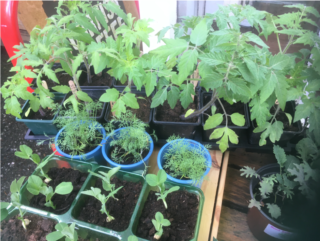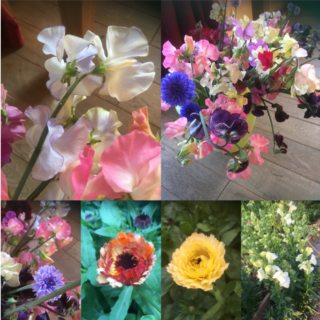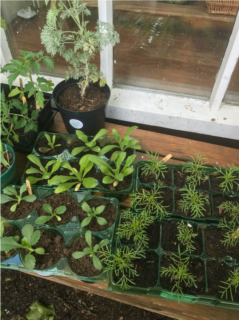Roseland Online June 2021
What a difference a few days make in the garden.
It has been, and not just from a gardening point of view, a thoroughly odd and unpredictable moth or two. Dry dry dry but cold April, followed by wet wet wet but still flipping cold May. Our annual plants (veg and flowers both) are so retarded as to be laughable. Facebook keeps throwing me “Memories” of flower photos I took over the past 2 or 3 years, and I just keep saying to myself “nope, haven’t got those in bloom yet”. There will definitely be a bit of a gap in our flower production for Veryan and Portloe Stores, and for other customers, but everyone is in the same boat so we just have to get on with it and make up some time. If you see me around, and I appear not to recognise you, it may not just be the mask – I will be working like a demon and tired as a zombie for the foreseeable.
 Hopefully, the sub 5 degree or colder night-time temperatures and frosts are a thing of the past (fingers crossed) and the game we are all playing with our gardening is catch up. But don’t let it spoil the experience. So what if your tomatoes and courgettes appear in July not June? They will still come. It’s not too late to sow some summer veg seed – carrots, beetroots, kohl rabi, turnips, courgettes, summer squash, cucumbers, salad and herbs of all sorts, peas, and so on. Your crop will just be arrive later and maybe even last longer. Some you will have missed the boat on though – spuds, parsnips, tomatoes, chillis and peppers, for example. They all need a long growing season, so if you can, source plants or just buy that particular foodstuff this year.
Hopefully, the sub 5 degree or colder night-time temperatures and frosts are a thing of the past (fingers crossed) and the game we are all playing with our gardening is catch up. But don’t let it spoil the experience. So what if your tomatoes and courgettes appear in July not June? They will still come. It’s not too late to sow some summer veg seed – carrots, beetroots, kohl rabi, turnips, courgettes, summer squash, cucumbers, salad and herbs of all sorts, peas, and so on. Your crop will just be arrive later and maybe even last longer. Some you will have missed the boat on though – spuds, parsnips, tomatoes, chillis and peppers, for example. They all need a long growing season, so if you can, source plants or just buy that particular foodstuff this year.
 Similarly, with annual flower seeds such as cornflower, nigella, ammi, helichrysum (strawflower), marigolds and calendula – soil and air temperatures are such that I would advocate sowing directly into well prepared flower beds now. Let’s face it, we have the longest day this month and after that, the days will start decreasing in length and annuals won’t get the daylight hours they really need to thrive.
Similarly, with annual flower seeds such as cornflower, nigella, ammi, helichrysum (strawflower), marigolds and calendula – soil and air temperatures are such that I would advocate sowing directly into well prepared flower beds now. Let’s face it, we have the longest day this month and after that, the days will start decreasing in length and annuals won’t get the daylight hours they really need to thrive.
Now that temperatures have risen, and those bitter winter winds seem to have left us for the moment at least, it is time to take a hard look at your evergreen shrubs, and decide if they need a tidy up or reducing in size. There is a relatively short window in which to prune these. You need to catch them just before growth starts in mid-spring, after any risk of frost or cold wind has passed, but before the heat of summer really emerges. A mid-spring start date will avoid frost and wind damage to new shoots, and the inevitable cut ends will soon be disguised by new growth. Stopping before the heat builds up will mean that your shrubs do not end up drought stressed by the summer sun, and will not look too scraggy as the bulk of its new growing will have been done for the year.
 You should leave any evergreens that are in flower or about to flower in mid-spring until that flowering has finished. Shrubs such as rhodis, azaleas and camellias often thrive better without any pruning at all, unless they become too unwieldy for their positions. If you do need to prune to control their size, leave until after flowering again, but in the case of camellias particularly, you need to act quickly when the window opens. These start forming their next year’s flower buds very soon after flowering, and if you leave pruning too late, you risk losing the following year’s blooms.
You should leave any evergreens that are in flower or about to flower in mid-spring until that flowering has finished. Shrubs such as rhodis, azaleas and camellias often thrive better without any pruning at all, unless they become too unwieldy for their positions. If you do need to prune to control their size, leave until after flowering again, but in the case of camellias particularly, you need to act quickly when the window opens. These start forming their next year’s flower buds very soon after flowering, and if you leave pruning too late, you risk losing the following year’s blooms.
There are some golden rules with pruning. First, make sure your pruning implements, whether they be secateurs or loppers, are sharp and clean. Ragged cuts and dirty tools make for fertile ground for disease to enter your plant. Secondly, remove the 3 D’s – dead, diseased and damaged material. That alone will make a difference and that may be all you need to do. If not, move on to number 3, which is trim and shape, always cutting back to just above a leaf bud, cutting on the diagonal. It is very tempting and easy to turn everything into a blobby mound, but keep taking steps back from your shrub and get the shape you want to see. Fourthly, if your shrub needs rejuvenation rather than just a trim, try to do this over 3 years, to avoid too much stress to the shrub. And finally, when you’re happy with the end result, give it a good feed with either a slow release granules or a seaweed-based liquid feed, and a good mulch, both applied around the base.
Something none of us can escape as the weather warms is weed growth. You can actually see them growing before your eyes at the moment. Weeding little and often really does help, but if they are just getting on top of you, there are a number of herbicides available now that conform to organic standards, satisfying your environmental conscience. These will certainly help with the annual weeds, but the perennials may take a bit more persuasion to leave. Then, it’s the trusty spade or fork, or something a little stronger in the chemical department, probably glyphosate-based. The reality of living in a rural setting, as most of us do, is that weeds will always be a part of our gardens, and there are some which actually are beneficial to wildlife and quite attractive to have lurking around the fringes. Find the balance which suits you best. Or just ignore them. We mostly do.
Helen Robins, Calendra Collective
calendracollective@outlook.com

